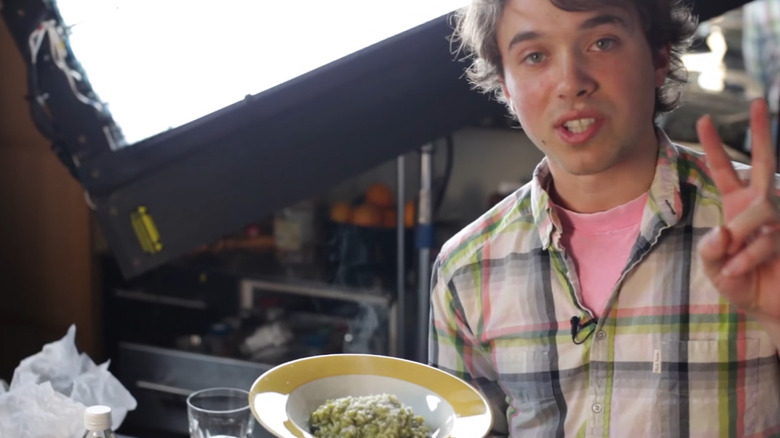How A Twitter Trend Became The Inspiration For Struggle Meals
You've probably heard the phrase "waste not, want not" or "willful waste makes woeful want" uttered by a parent or grandparent at some point in your life. Well, in the world of cooking, there is a movement led by the likes of Andrew Zimmern and Jamie Oliver to cut down on food waste, and those sayings really get to the heart of it. Per the U.S. Environmental Protection Agency, food takes up more room in U.S. landfills than any other item. In the United States alone, according to the EPA, we had an eye-popping 35 million tons of food waste in 2018, and still there are individuals and families who struggle to put food on the table. That's why celebrity chefs like Frankie Celenza have found a growing platform.
The host of "Struggle Meals" was tired of expensive university meal plans, which prompted him to find a cheaper alternative and he came up with inexpensive but tasty dishes for himself and his college friends (via CNBC). Celenza told Acorns, "Meals are three opportunities to enjoy, savor, and relish the amazing world we live in. ... Be that creative person, save money, master a skill for life (cooking), and ultimately, I guarantee you'll enjoy the good life more." It's that philosophy that brought producers from Tastemade knocking at Celenza's door when they noticed #strugglemeals trending on Twitter, according to Beyondish.
"Struggle Meals" was born out of a hashtag
Celenza revealed to Beyondish that it was a Twitter hashtag that prompted Tastemade to create the series for which he is known. "At Tastemade, everyone's always scouring the internet for trends and interests. In late 2017, #strugglemeals was trending, so they came to me and said, 'Would you host a show by that name?'" he said. If you don't know what a struggle meal is, per Food Beast, it's when your fridge and cabinets are almost empty, you're down to your last few bucks, and you need to feed your family. That's probably why Celenza is so popular. He shows viewers how to make the most of the ingredients they do have or how to turn $2 into a hearty, nutritious meal.
In fact, according to the L.A. Times, "Struggle Meals" was so popular during the COVID-19 lockdown, that Tastemade have decided to create an international version of the show. And Celenza's biggest tip for saving money and not wasting food, he told Acorns, is "planning on using everything you buy." Celenza went on to explain that there are huge money savings to be had when you do. He said, "With the average American spending $2,400 a year on food, that's [about an extra] $1,000 in your pocket. There's a serious monetary incentive for you not to waste food. It's way bigger than canceling a Netflix subscription. Save leftovers, turn them into an egg frittata the next day, and buy less."

